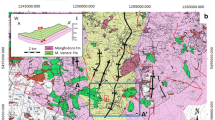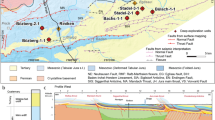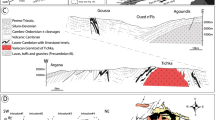Abstract
At the Chizeh copper deposit, high concentrations of visible copper are hosted in shaley tuffite of the Eocene Karaj Formation at the southwest-dip** limb of the Tarom anticline. The 20–25-m thick layer is characterized by conjugate stratabound fractures indicating structural controls of mineral precipitation. The anticline was formed during the Alborz orogeny phase. It has multiple fractures with NW–SE, N-S, NE-SW, and E-W trends, which have been formed during multiple tectonic phases. Here, we distinguish the role of fractures in mineralization of the Chizeh area by investigating the deposit-scale structural framework using a combination of mesoscopic, microscopic, and statistical analyses. Mesoscopic and microscopic structural analyses, including measurement of the orientations of fractures, veins, and veinlets, indicate that the vein minerals were subject to a vertical least principal stress (σ3) and a horizontal maximum principal stress (σ1) normal to the strike of bedding. It is consistent with the sub-horizontal σ1 inferred from the regional stress field associated with N-S shortening. Statistical analyses show that the fractures at fold limbs are more developed in the incompetent units such as shaley tuffite than in the other layers such as porphyritic-andesite and dacitic-andesitic volcanic tuff during the folding. These stratabound fractures are therefore interpreted to have been preferential fluid flux conduits in the Chizeh deposit site. This new structural analysis for the Chizeh deposit highlights that fluid flow and hydrothermal mineralization are strongly controlled by flexural-slip folding-induced stratabound fractures.











Similar content being viewed by others
References
Afshar NS, Rahimi A, Rezaeian M, Nabaei T (2020) Folding mechanism investigation of the Tarom Metallogenic Zone based on fracture patterns, NW Qazvin. Tectonics Journal 4:1–20 (in Persian)
Ali KHG (2013) Structural control of El Sela granites and associated uranium deposits, Southern Eastern Desert. Egypt Arabian J Geosci 6:1753–1767
Al-Kindi MH (2020) Understanding the relationship between large-scale fold structures and small-scale fracture patterns: a case study from the Oman Mountains. Geosciences 10:1–28
Asiabanha A, Foden J (2012) Post-collisional transition from an extensional volcanosedimentary basin to a continental arc in the Alborz Ranges, N-Iran. Lithos 148:98–111
Baecher GB, Lanney NA (1978) Sampling for joint persistence. 19th U. S. National Symposium on Rock Mechanics
Balberg I, Binenbaum N (1983) Computer study of the percolation threshold in a two-dimensional anisotropic system of conducting sticks. Phys Rev B28:3799–3812
Bazarganlari A (2007) Basilar concepts of statistic and presumption. Nashre Ayeejg publication, Tehran (in Persian)
Behyari M, Rahimsouri Y, Hoseinzadeh E, Kurd N (2019) Evaluating of lithological and structural controls on the barite mineralization by using the remote sensing, fry and fractal methods, Northwest Iran. Arabian J Geosci 12. https://doi.org/10.1007/s12517-019-4298-z
Bellahsen N, Fiore P, Pollard DD (2006a) The role of fractures in the structural interpretation of Sheep Mountain Anticline, Wyoming. J Struct Geol 28:850–867
Bellahsen N, Fiore PE, Pollard DD (2006b) From spatial variation of fracture patterns to fold kinematics; a geomechanical approach. Geophys Res Lett 33:L02301
Bergbauer S, Pollard DD (2004) A new conceptual fold-fracture model including prefolding joints, based on Emigrant Gap anticline, Wyoming. Geol Soc Am Bull 116:294–307
Castro A, Aghazadeh M, Badrzadeh Z, Chirro M (2013) Late Eocene-Oligocene post collisional monzonitic intrusions from the Alborz magmatic belt, NW Iran. An example of monzonite magma generation from a metasomatized mantle source. Lithos 180:109–127
Chauvet A (2019) Structural Control of Ore Deposits: The role of pre-existing structures on the formation of mineralised vein systems. Minerals 9:1–22
Chi G, Guha J (2011) Microstructural analysis of a subhorizontal gold-quartz vein deposit at Donalda, Abitibi greenstone belt, Canada: implications for hydrodynamic regime and fluid-structural relationship. Geosci Front 2(4):529–538
Cooke ML, Simo JA, Underwood CA, Rijken P (2006) Mechanical stratigraphic controls on fracture patterns within carbonates and implications for groundwater flow. Sed Geol 184:225–239
Cosgrove JW, Ameen MS (2000) A comparison of the geometry, spatial organization and fracture patterns associated with forced folds and buckle folds. Geol Soc Spec Pub 169:7–21
Cox SF, Etheridge MA, Cas RAF, Clifford BA (1991) Deformational style of the Castlemaine area, Bendigo-Ballarat Zone: implications for evolution of crustal structure in central Victoria. Aust J Earth Sci 38:151–170
Evans MA, Fischer MP (2012) On the distribution of fluids in folds: a review of controlling factors and processes. J Struct Geol 44:2–24
Evans MA, Bebout GE, Brown CH (2012a) Changing fluid conditions during folding: an example from the central Appalachians. Tectonophysics 1:99–115
Evans MA, Leo J, Burruss RC (2012b) Spatial and temporal variation of fluids in the Devonian Marcellus shale during deformation of the central Appalachian fold-and-thrust belt. In: Roure, F. (Ed.), Proceedings. Geofluids VII- International Conference, IFP Energies nouvelles, Rueil-Malmaison, France, June 6–8
Evans MA (2010) Temporal and spatial changes in deformation conditions during the formation of the Central Appalachian fold-and-thrust belt: evidence from joints, vein mineral paragenesis, and fluid inclusions. In: Tollo R, Bartholomew MJ, Hibbard J, Karabinos P (Eds.), From Rodinia to Pangea: The Lithotectonic Record of the Appalachian Region. Geological Society of America Memoir 206, 477–552
Fischer MP, Wilkerson MS (2000) Predicting the orientation of joints from fold shape: results of pseudo-three-dimensional modeling and curvature analysis. Geol Magazine 28:15–18
Floreznino JM, Aydin A, Mavko G, Antonellini M, Ayaviri A (2005) Fault and fracture systems in a fold and thrust belt: an example from Bolivia. Am Asso Petrol Geol Bull 89(4):471–493
Gessner K, Jones PA, Wilde AR, Kühn M (2006) Significance of strain localization and fracturing in relation to hydrothermal mineralization at Mount Isa, Australia. J Geochem Explor 89:129–132
Ghorbani M (2013) The economic geology of Iran, mineral deposits and natural resources. Springer, Dordrecht New York, p 569
Guerriero V, Iannace A, Mazzoli S, Parente M, Vitale S, Giorgioni M (2010) Quantifying uncertainties in multi-scale studies of fractured reservoir analogues: implemented statistical analysis of scan line data. J Struct Geol 32:1271–1278
Guerriero V, Mazzoli S, Iannace A, Vitale S, Carravetta A, Strauss C (2013) A permeability model for naturally fractured carbonate reservoirs. Mar Pet Geol 40:115–134
Guerriero V, Dati F, Giorgioni M, Iannace A, Mazzoli S, Vitale S (2015) The role of stratabound fractures for fluid migration pathways and storage in well-bedded carbonates. Italian J Geosci 134:383–395
Guo L, Latham JP, **ang J (2017) A numerical study of fracture spacing and through-going fracture formation in layered rocks. Int J Solids Struct 110–111:44–57
Guzofski CA, Mueller JP, Shaw JH, Muron PMDA, Bilotti F, Rivero C (2009) Insights into the mechanisms of fault-related folding provided by volumetric structural restorations using spatially varying mechanical constraints. Am Asso Petrol Geol Bull 93:479–502
Helgeson DE, Aydin A (1991) Characteristics of joint propagation across layer interfaces in sedimentary rocks. J Struct Geol 13:897–911
Hirayama K, Samimi M, Zahedi M, Hushmandzadeh A (1966) Geology of the Tarom district, western part (Zanjan area, north-west Iran). Geol Survey Iran, Scale 1(100):000
Hooker JN, Gale JFW, Gomez LA, Laubach SE, Marrett R, Reed RM (2009) Aperture-size scaling variations in a low-strain opening-mode fracture set, Cozzette Sandstone, Colorado. J Struct Geol 31:707–718
Hooker JN, Laubach SE, Marrett R (2014) A universal power-law scaling exponent for fracture apertures in sandstones. Geol Soc Am Bull 126:1340–1362
Huang Q, Angelier J (1989) Fracture spacing and its relation to bed thickness. Geol Magazine 126:326–355
Khouei N., Ghorbani M, Tajbakhsh P (1999) Copper deposits in Iran. In: Geological Survey of Iran. Geological Survey of Iran, Tehran, p. 251 (in Persian)
Kouhestani H, Mokhtari MAA, Chang Z, Johnson AC (2018) Intermediate sulfidation type base metal mineralization at Aliabad-Khanchy, Tarom-Hasht** metallogenic belt, NW Iran. Ore Geol Rev 93:1–18
Lacombe O., Bellahsen N, Mouthereau F (2011) Fracture patterns in the Zagros Simply Folded Belt (Fars, Iran): constraints on early collisional tectonic history and role of basement faults. In: Lacombe O, Grasemann B, Simpson G (Eds.). Geological Magazine 148, 940–63
Laubach S, Diaztushman K (2009) Laurentian paleostress trajectories and ephemeral fracture permeability, Cambrian Eriboll Formation sandstones west of the Moine thrust zone, northwest Scotland. J Geol Soc London 166(2):349–362
Laubach SE (1989) Paleostress directions from the preferred orientation of closed microfractures (fluid-inclusion planes) in sandstone, East Texas basin, U.S.A. J Structural Geol 11/5, 603–11
Lisle RJ (2000) Predicting patterns of strain from three-dimensional fold geometries: neutral surface folds and forced folds. In: Cosgrove JW, Ameen MS (Eds.) Forced Folds and Fractures. J Geol Soc London 169:213–21
Nabatian G, Jiang SY, Honarmand M, Neubauer F (2016) Zircon U-Pb ages, geochemical and Sr–Nd–Pb–Hf isotopic constraints on petrogenesis of the Tarom-Olya pluton, Alborz magmatic belt, NW Iran. Lithos 244:43–58
Nabavi ST, Fossen H (2021) Fold geometry and folding – a review. Earth Sci Rev 222:1–62
Odling NE, Gillespie P, Bourgine B, Castaing C, Chile´s JP, Watterson J (1999) Variations in fracture system geometry and their implications for fluid flow in fractured hydrocarbon reservoirs. Pet Geosci 5(4):373–384
Ougier-Simonin A, François R, Boehm C, Vidal-Gilbert S (2016) Microfracturing and microporosity in shales. Earth Sci Rev 162:198–226
Pluijm B, Marshak S (2004) Earth structure: an introduction to structural geology and tectonics. WW Norton & Company, USA, p 673
Price NJ, Cosgrove JW (1990) Analysis of geological structures. Cambridge University Press, p. 520
Procter A, Sanderson DJ (2018) Spatial and layer-controlled variability in fracture networks. J Struct Geol 108:52–65
Ramsay JG (1967) Folding and fracturing of rocks. McGraw-Hill, New York, p 568
Ramsay JG, Huber MI (1987) The techniques of modern structural geology, folds and fractures. Academic Press, New York, p 695
Rives T, Razack PJP, Rawnsley KD (1992) Joint spacing : analogue and numerical simulations. J Struct Geol 14:925–937
Shahbazi S, Ghaderi M, Alfonso P (2019) Mineralogy, alteration, and sulfur isotope geochemistry of the Zehabad intermediate-sulfidation epithermal deposit, NW Iran. Turkish J Earth Sci 28:882–901
Sibson RH (2001) Seismogenic framework for hydrothermal transport and ore deposition. Soc Econ Geol Rev 14:25–50
Snow DT (1970) The frequency and apertures of fractures in rock. Int J Rock Mechanics Mining Sci Geomechanics Abstracts 1:23–30
Stearns DW (1968) Certain aspects of fractures in naturally deformed rocks. In Riecker RE (ed.) Rock mechanics seminar: Bedford. Terrestrial Sciences Laboratory, 97–118
Stocklin J, Eftekharnezhad J (1969) Geological map of Zanjan. Geol Survey Iran, Scale 1:250000
Tanner PWG (1989) The flexural-slip mechanism. J Structural Geol 12:1084–1087
Verdel C, Wernicke BP, Hassanzadeh J, Guest B (2011) A Paleogene extensional arc flare-up in Iran. Tectonics 30(3):1–20
Vermilye JM, Scholz CH (1998) The process zone: a microstructural view of fault growth. J Geophys Res 103(B6):12223–12237
Yasami N, Ghaderi M, Madanipour S, Taghiloub B (2017) Structural control on overprinting high-sulfidation epithermal on porphyry mineralization in the Chodarchay deposit, northwestern Iran. Ore Geol Rev 86:212–224
Acknowledgements
This research was derived from the Ph.D thesis of the first author and supported by the Golestan University, Gorgan, Iran. Thanks are also given to Payame Noor University, Qazvin and Institute for Advanced Studies in Basic Sciences, Zanjan, for great assistance during the preparation of the manuscript. We also would like to express our great appreciation to editor-in-chief and reviewers for their very useful and constructive comments and suggestions for improvement of the manuscript.
Author information
Authors and Affiliations
Corresponding author
Ethics declarations
Conflict of interest
The authors declare that they no competing interests.
Additional information
Responsible Editor: François Roure
Rights and permissions
Springer Nature or its licensor (e.g. a society or other partner) holds exclusive rights to this article under a publishing agreement with the author(s) or other rightsholder(s); author self-archiving of the accepted manuscript version of this article is solely governed by the terms of such publishing agreement and applicable law.
About this article
Cite this article
Najafi, S.A., Rahimi, A., Nabaei, T. et al. Role of flexural-slip folding-induced stratabound fractures in controlling Cu mineralization at the Chizeh deposit, Tarom metallogenic zone, NW Iran. Arab J Geosci 16, 94 (2023). https://doi.org/10.1007/s12517-022-11171-6
Received:
Accepted:
Published:
DOI: https://doi.org/10.1007/s12517-022-11171-6




